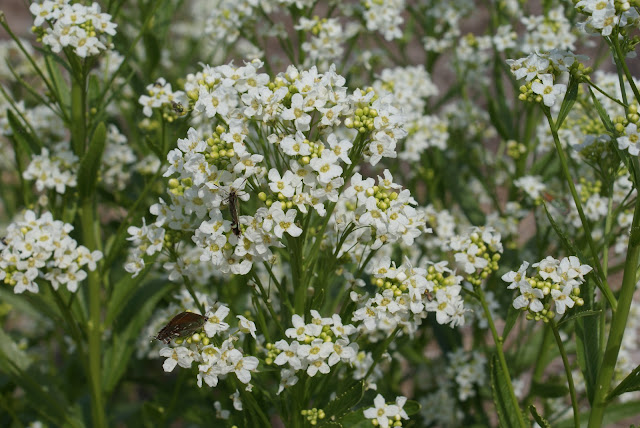 |
| Pretty flower (blue flax) to distract me. |
It's always something.
Every year, I am met with some new challenge in the garden.
Frequently, it is not a permanent challenge, but some out of ordinary circumstance -- like excessive heat and drought, etc.
This year, it's cutworms.
Cutworms have not been an issue in my gardens for, well, all of the decades I have been gardening.
Sure, every once in a while a plant or two would get taken out by cutworms. But it has never been wholesale slaughter of seedlings.
Until this year.
Did the warm winter allow more of the eggs of these critters to survive?
Did the exceptionally warm March weather cause them to hatch early, thus threaten my young cabbages and peas?
 |
| Cutworm!!!!!!! |
Or is it that my early spring plantings were made in beds that had other veggies growing in them until frost, allowing the cutworm adults to lay eggs among the plants?
Whatever it is, my stress-reducing activity of gardening has briefly become a source of stress.
My husband discovered the cutworm issue when he was watering the newly planted seedlings one day. Almost half of the cauliflower plants had been taken down. So I replaced the plants and on Wednesday (after waiting all day for it to rain) I went out to water them in the afternoon and found other plants had been taken out. Grrr.
"Cutworm" is a name given to the larvae of nearly 3,000 species of moths. I am not sure which species this is in my garden, but it is one of those that likes to cut the seedling off just above soil level.
Sometimes they'll just nip off a leaf that's close to the ground. Once a seedling's stem is too large for the worm to wrap itself around, the plant is safe. So, if you can get the plants in the ground and large enough before the cutworms hatch, they won't get chopped down. But even later planted seedlings have not been much bothered by cutworms in my garden... before. Who knows what will happen this year.
Sigh.
 |
| Pretty Moon, to distract me.... |
Yesterday morning I went out again to check on the plants -- because the cutworms feed at night and are closer to the soil surface in the morning. Dig in the soil around the base of a damaged plant, find the little buggers and take them out... it's gooey, but it's got to be done. The worms in my garden are kind of mud colored, unless they have a bit of green to them, and are difficult to find in the dirt. (Different species have different looks. Even the same species can vary.) But persistence pays. I found many of them.
When I checked on the plants yesterday, I took a bunch of long nails out with me. I didn't use the nails to stab the worms, no. Ew. Sticking a nail, or other similar object up against the seedling stem helps protect the plant because the cutworm must be able to wrap itself entirely around the stem to cut it off.
An older gardener told me her father use to put nails next to all of his tomato seedlings. Even
K-State Research and Extension cites that as viable protection.
Since my brassica seedlings tend to have rather crooked little stems, the effort is kind of iffy... I used two nails stuck in at different angles on some plants.
I have seen pictures online of small plastic yogurt containers, cans, etc. placed around seedlings (not up against the stems) to ward off cutworms. I suppose that would work if the cutworms were not already near the plants. Such guards must extend a couple of inches into the soil as well as above it, since the cutworms tunnel.
Other deterrents and preventions work as well, especially if you plan ahead. Here are
more tips to try.
Cutworms also have been working on nearby radish and pea seedlings (do we even have enough nails?), and probably are responsible for the disappearance of most of the mizuna and spinach seedlings. Sigh.
At least the weather has become more April-like, instead resembling late May and early June.
It finally did rain on Wednesday, just as I was about finished with the watering. My backside got dampened as I finished my cutworm search and rolled up the hoses.
However, the rainfall wasn't sufficient to eliminate the need to water. Today I will set the sprinkler out in the newly planted grass, pick some greens, weed around some of the fruit trees, start some basil seeds and (maybe) check to see if the nails thwarted the cutworms. I am not sure I really want to look.
All I know, is that the tomato, pepper and eggplant seedlings will get nailed when I put them in the garden.



















